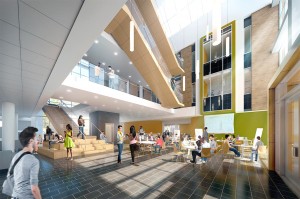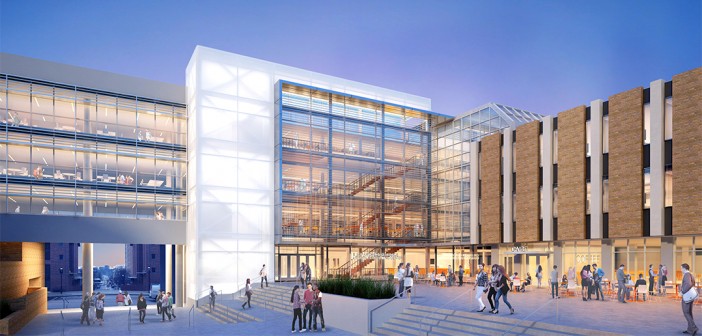
A digital rendering of the potential new entrance of FML library. (Courtesy of CannonDesigns)
As technology becomes the center of education across college campuses, those in Library and Technology Services at Lehigh have recognized the need for an upgrade of E.W. Fairchild-Martindale Library to make it “a library of the future,” according to Bruce Taggart, the vice provost for Library and Technology Services.
A multi-million dollar project called EWFM 2020, has been proposed to update the library. The plan focuses on the developing use of technology, collaboration and creativity in education.

A digital rendering of the potential new interior of the main room of FML library. (Courtesy of CannonDesigns)
“There are a lot of courses at Lehigh that are mainly group work courses and there aren’t a lot of places in Fairchild-Martindale . . . for students to come and talk, so it makes it hard when you have a group project and you want to be able to collaborate with them but you don’t know where to go,” TRAC fellow Amanda Donohue, ’17, said. “Even if people are doing their own individual work but they want to do it together, I think that it’s a much more inviting, productive way of doing work than just sitting in a little cubicle by yourself.”
To accommodate the needs of students, faculty and staff over the past years, Library and Technology Services has conducted several smaller projects, such as turning the basement floor into a cafe area with the Center for Innovation in Teaching and Learning and deaccessioning stacks of government documents from the fifth floor. They now hope to organize the larger project and focus on improving the entire library instead of individual sections.
Nine years ago, Linderman Library was renovated to upgrade the technology and introduce space for collaboration in the previously outdated building. Taggart said those involved with the renovation from Library and Technology Services were determined to preserve the historic characteristic of the building. With EWFM, however, they have more room for development in the ways they want because they do not have to focus on preserving the history of the building, which was built in 1969 and renovated in 1985.
The tagline for Linderman’s renovation was “Renovation, Preservation, Transformation.” For Fairchild-Martindale, it is “Connect, Collaborate, Create.”
“Finally we thought that maybe there was a holistic way we could look at this, just as we did with Linderman,” Taggart said. “Once we looked at the whole envelope and we looked at the possibilities and hired a good architect, it was really about trying to provide the spaces for creativity, thinking, student collaboration and teaching.”
To shift the focus of the building to collaboration and teaching, several changes will have to be made. Library and Technology Services started its planning by looking at the library designs at other universities as well as seeking student opinions.
Sherri Yerk-Zwickl, the director of planning and administration in Library and Technology Services, said it would be impossible for all of the changes to be made at the same time without completely closing the library for several years because of the nature of the plans. Instead, the changes will be phased in, allowing students to utilize the the benefits of the redesigned space as they take place.
The plan, created by the design firm CannonDesign, will add about 315 seats for student use, totaling about 1,255 throughout the library. These will be split into 22 study groups, five classrooms, two computer labs and a special-purpose room, according to the EWFM 2020 plan.
To make room for these seats, stacks of books will also be made digital or completely deaccessioned, depending on their importance and use in the past years.
“The library very much is still a place that people need to access information,” Yerk-Zwickl said. “Some of that information is physical and will remain physical with all of the books that we have. A lot of that information, though, is increasingly digital.”
Some other changes include moving the Center for Innovation in Teaching and Learning from the ground floor to the fifth floor, where a collaborative space has already been created. The current Center for Innovation in Teaching and Learning will be expanded into a larger space, and the cafe will be moved upstairs and spread into the outdoor plaza. They also hope to make it more accessible for those with disabilities.
Even with the need for collaborative spaces, Library and Technology Services recognizes the need for quiet spaces.
“In general, we are thinking that the higher up in the library you come, the quieter it’s going to get,” Yerk-Zwickl said. “We realize we need to have spaces where people can have just complete silence where they can focus.”
Greg Reihman, the associate vice provost and director for the Center for Innovation in Teaching and Learning, said one of the main goals is to keep the new renovations open to further development in the future.
In accordance with the plan, Library and Technology Services has been looking ahead at what libraries could be like 25 to 30 years from now and how they can keep up with the changing needs without completely renovating the space again.
“We want to make the vision for it be flexible enough so that as Lehigh has new initiatives, new ideas and new needs, that the space isn’t locked down on one particular vision,” Reihman said. “We are going to be changing what we do and what we need the space for all the time.”
They are also looking at how Fairchild-Martindale and the academic buildings on campus can have a transparent and synergistic relationship, so they can assist each other in meeting the needs of the Lehigh community.
With so many buildings now being renovated on campus, including the University Center, Chandler-Ullmann and Christmas-Saucon, those in Library and Technology Services hope their plan stands out among the rest and will be approved.
“I think part of what might help those decisions is understanding what is the relative cost and then what is the benefit,” Yerk-Zwickl said. “One of the benefits is that the library is a place for everyone. If you were going to prioritize, you might want to go with the aspect of this is a space that benefits everyone across campus.”






Comment policy
Comments posted to The Brown and White website are reviewed by a moderator before being approved. Incendiary speech or harassing language, including comments targeted at individuals, may be deemed unacceptable and not published. Spam and other soliciting will also be declined.
The Brown and White also reserves the right to not publish entirely anonymous comments.